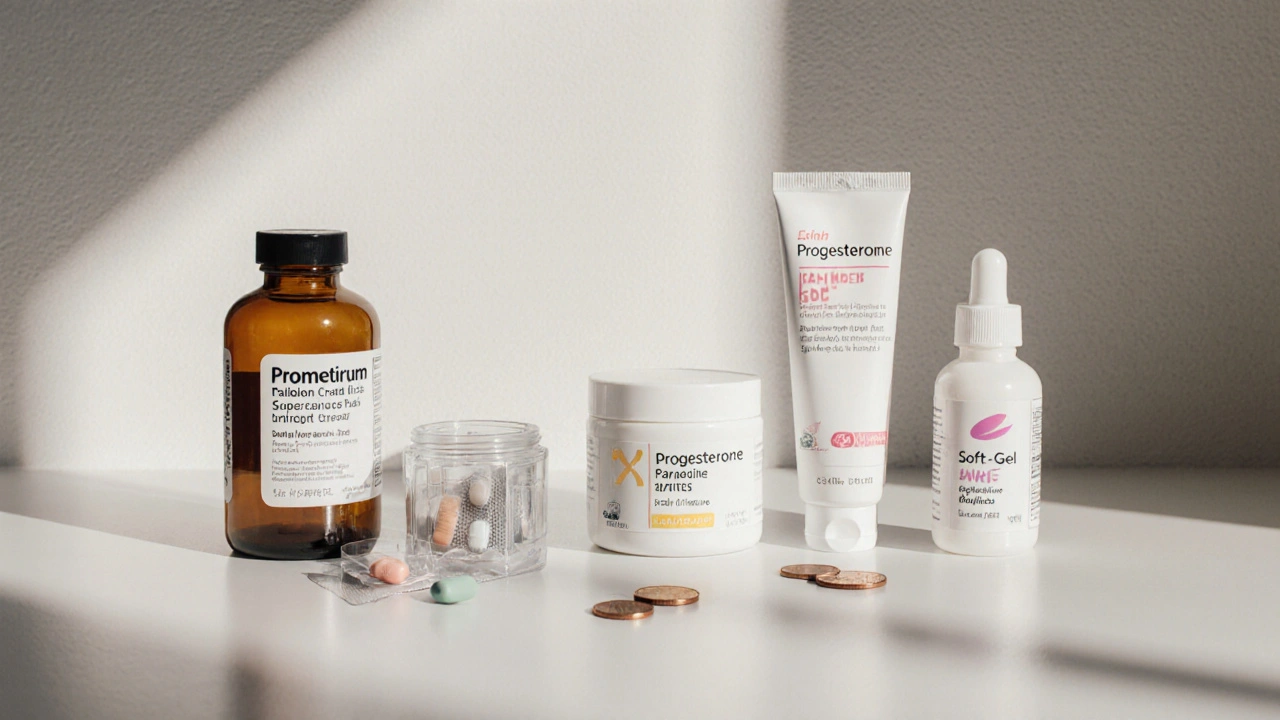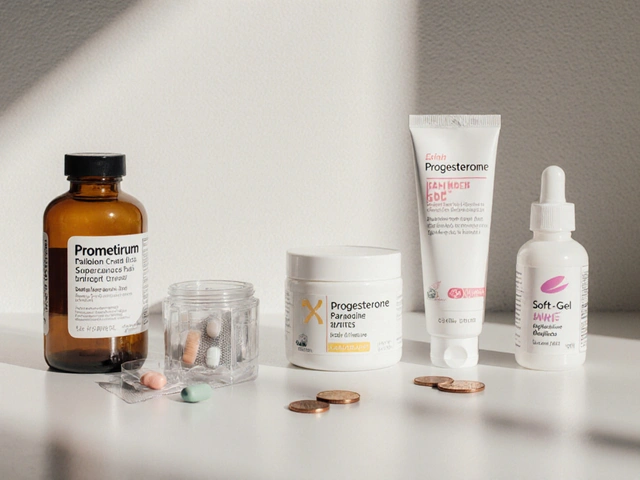Progesterone Alternative Selector
Select your situation to find the best progesterone alternative:
Quick Summary
- Prometrium is an oral micronized progesterone taken for menopause symptoms and IVF support.
- Common alternatives include vaginal gels (Crinone, Endometrin), synthetic progestins (Duphaston, Medroxyprogesterone acetate), and topical creams.
- Oral capsules have higher systemic exposure but can cause drowsiness; vaginal forms act locally with fewer systemic side‑effects.
- Cost varies widely - generic synthetic progestins are cheapest, while bioidentical formulations tend to be pricier.
- Choosing the right product depends on your condition, tolerance, insurance coverage, and personal preference.
What Is Prometrium?
When you hear the name Prometrium is an oral micronized progesterone capsule approved for hormone‑replacement therapy (HRT) and luteal‑phase support in assisted reproduction. The capsule delivers progesterone in a form that the body can absorb well, mimicking the hormone your ovaries would normally make after ovulation.
Typical dosing for menopause ranges from 100mg to 200mg nightly, while fertility protocols often start with 200mg twice daily after embryo transfer. Because it’s taken by mouth, the drug passes through the liver first, which can cause a mild sedative effect for some users.
Why Do People Look for Alternatives?
Not everyone tolerates the sleepiness or the taste of the oil‑based capsules. Some clinicians prefer a route that drops the hormone straight into the uterus, especially for IVF patients. Others want a cheaper option that insurance will cover without a prior‑authorization headache. These needs have spawned a range of alternatives, each with its own pros and cons.
Common Progesterone Alternatives
Below are the most frequently discussed substitutes. Each entry includes a brief definition with microdata so search engines can grasp the relationships.
Crinone is a vaginal gel containing micronized progesterone, usually prescribed for luteal‑phase support in IVF cycles. It’s applied once daily at the bedtime and delivers the hormone directly to the uterus, bypassing the liver.
Endometrin is a vaginal insert that releases progesterone over 8‑12hours, used for both HRT and fertility treatments. The insert is convenient for women who dislike gels or creams.
Duphaston is a synthetic progestin called dydrogesterone, taken orally, that mimics natural progesterone but has a lower risk of sedation. It’s often prescribed in Europe and Canada for menstrual disorders.
Medroxyprogesterone acetate is a synthetic progestin sold under brand names like Depo‑Provera, available as an oral tablet or injectable depot. It’s cheap and widely covered by insurance, though it carries a higher risk of weight gain.
Natural progesterone cream is a transdermal preparation that claims to deliver bioidentical progesterone through the skin, popular in DIY hormone‑balancing circles. Absorption is variable and scientific support is limited.
Bioidentical hormone replacement therapy (BHRT) is a customized regimen of hormone compounds (including progesterone) that match the chemical structure of hormones produced by the body. Compounded pharmacies create individualized doses, but quality control can be inconsistent.

Head‑to‑Head Comparison
| Attribute | Prometrium (Oral) | Crinone (Vaginal Gel) | Endometrin (Vaginal Insert) | Duphaston (Synthetic Oral) | Medroxyprogesterone Acetate (Synthetic) |
|---|---|---|---|---|---|
| Form | Capsule | Gel (0.8g) | Insert (200mg) | Tablet (10-20mg) | Tablet 10mg / Injection 150mg |
| Typical Dose | 100-200mg nightly | 90mg once nightly | 200mg once nightly | 20mg daily | 10mg daily or 150mg every 3months (injectable) |
| Bioavailability | ~30% (first‑pass hepatic metabolism) | ~70% (direct uterine delivery) | ~80% (local release) | ~50% (synthetic, less first‑pass effect) | ~60% (tablet); 100% (depot injection) |
| Common Uses | Menopause HRT, luteal support | IVF luteal support | HRT & IVF | Menstrual disorders, endometriosis | Contraception, endometrial protection |
| Side‑Effect Profile | Drowsiness, bloating, breast tenderness | Vaginal irritation, discharge | Local irritation, rare systemic effects | Headache, mild nausea | Weight gain, mood changes, bone density loss with long‑term use |
| Average Monthly Cost (USD) | $30‑$45 | $120‑$150 | $90‑$110 | $15‑$25 | $10‑$20 (tablet) / $45‑$60 (injectable) |
How to Pick the Right Progesterone Option for You
There’s no one‑size‑fits‑all answer, but a simple decision tree can clarify your path.
- What’s the primary reason? If you’re undergoing IVF, a vaginal gel or insert often yields the most reliable uterine levels. For general menopausal symptoms, oral Prometrium or a low‑dose synthetic progestin works well.
- Do you experience night‑time drowsiness? If yes, consider a non‑sedating synthetic like Duphaston or the injectable version of medroxyprogesterone.
- How important is cost? Generic synthetic progestins (Medroxyprogesterone acetate) are the cheapest, while bioidentical creams and vaginal inserts can add up quickly.
- Any insurance constraints? Many insurers cover oral synthetics more readily than compounded BHRT or vaginal gels. Check your formulary before committing.
- Personal comfort with administration route? If you dislike inserting products, stay with oral forms. If you’re okay with a nightly gel, you’ll likely see fewer systemic side‑effects.
Talk to your prescriber about these factors. A short trial of 2‑3 weeks can reveal tolerance before you lock in a long‑term plan.
Potential Pitfalls and How to Avoid Them
Missing doses - Oral pills are easy to forget, especially if you’re sleepy after taking them. Set a phone alarm or keep the bottle by your bedside.
Drug interactions - Progesterone can affect the metabolism of certain anticonvulsants and antiretrovirals. Always list every medication with your doctor.
Improper storage - Vaginal gels must stay at room temperature; freezing them reduces efficacy. Keep capsules in a cool, dry place.
Assuming “natural” means safe - Over‑the‑counter creams often contain fillers that can cause skin reactions. Patch‑test a small area first.
Next Steps After Reading This Guide
- Make a short list of 2‑3 options that match your priorities.
- Schedule a brief visit (or tele‑visit) with your gynecologist or reproductive endocrinologist.
- Ask for a trial prescription or sample to test tolerance.
- Check your pharmacy or insurance portal for cost comparisons.
- Keep a symptom diary for at least one menstrual cycle or 30days of HRT.
Frequently Asked Questions
Can I switch from oral Prometrium to a vaginal gel without a wash‑out period?
Yes. Because both products deliver progesterone, you can transition directly. However, start the gel at the same time you stop the capsules and monitor for any new side‑effects. A short discussion with your prescriber is still advisable.
Is synthetic progesterone less effective than bioidentical hormone therapy?
Effectiveness depends on the indication. For preventing endometrial hyperplasia, synthetic progestins work just as well. For menopause symptom relief, many women report a more natural feeling with bioidentical progesterone, but clinical outcomes are comparable.
Do progesterone creams raise my blood progesterone levels?
Topical absorption is unpredictable. Small studies show modest increases, but levels usually stay far below therapeutic thresholds. If you need a precise dose, oral or vaginal routes are preferable.
What are the risks of long‑term medroxyprogesterone acetate use?
Extended use can lead to weight gain, mood swings, and decreased bone mineral density. It’s often prescribed for short‑term cycles (e.g., 3‑month depot) rather than continuous therapy.
Is there a benefit to using compounded BHRT over FDA‑approved products?
Compounded BHRT offers personalized dosing and the ability to combine hormones in one cream, but quality control varies widely. FDA‑approved products like Prometrium have standardized potency and proven safety data.









